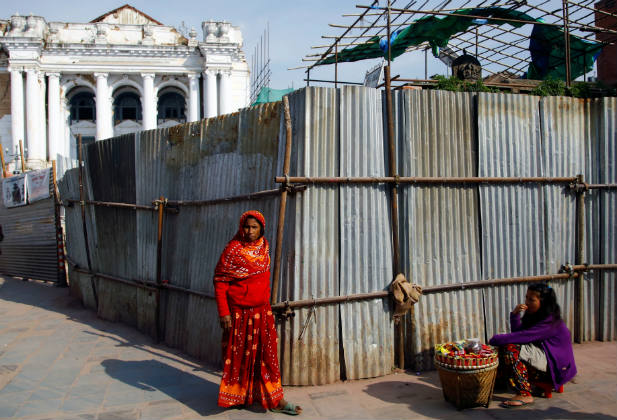Women Rebuild Nepal Post-Earthquake

More on:
Voices from the Field features contributions from scholars and practitioners highlighting new research, thinking, and approaches to development challenges. This article is authored by Anna Applebaum and Briana Mawby, the 2015-2017 Hillary Rodham Clinton Research Fellows with the Georgetown Institute for Women, Peace and Security, and Melanne Verveer, the executive director of the Georgetown Institute for Women, Peace and Security.
Today marks two years since a massive earthquake and violent aftershock leveled Nepal, killing 9,000 people, injuring an additional 22,000 people, and affecting roughly one quarter of the country’s population. In the months following the earthquake, Nepali women played a crucial yet underappreciated role in relief efforts, and many continue to help the country as it moves into long-term recovery efforts.
On April 25, 2015 a 7.8 magnitude earthquake struck near the capital of Nepal, already one of the poorest countries in Asia. The quake was so powerful that it shifted Mount Everest by more than an inch. Nearly 800,000 buildings were damaged or destroyed by the quake and its 7.3 magnitude aftershock, leaving thousands to live outside with limited access to water and electricity. The earthquake not only destroyed homes, offices, and infrastructure but also disrupted social, economic, and political processes in the country. All told, the economic impact from the earthquake’s damage was estimated at around $7 billion.

Women did not hesitate to respond to the crisis. Women’s organizations leapt into action to mobilize volunteers and provide aid to survivors by distributing food, medicine, clothing, and monetary support. Many of these organizations paid special attention to the needs of women, delivering maternity and baby care kits and providing special care for pregnant women, lactating women, and adolescent girls. They offered psychosocial support, created safe space for women to gather, and connected survivors to formal humanitarian aid and legal services. These organizations worked quickly and built networks to maximize their reach. International actors played a significant role in providing relief, but Nepali women were often the first responders in communities affected by the disaster.
In their communities, women took on additional responsibilities to care for their families and neighbors, including some traditionally “male” recovery activities. The gender dynamics of Nepali society were shifting even before the disaster struck due to the number of Nepali men who work overseas. With around seven percent of Nepalis—mostly men—living abroad, women often headed households and assumed sole responsibility for tending children, parents, and farms. Following the earthquake, it fell to many women to help clear houses and rubble, often considered a man’s job. Women frequently assumed responsibility for rebuilding their homes and gathering food, shelter, clothing, and medicine for themselves and their families.
Nepali women took on these roles in spite of the serious and disproportionate impact the earthquake had on women. A 2007 study by the London School of Economics and the University of Essex found that the worse the natural disaster, the bigger the gender disparity in its impact. Nepal was no exception. More women and girls died in the quake than men and boys, according to the government of Nepal. Women who survived were also harder hit because of their disadvantaged economic and social standing.
Following the earthquake, Nepali women faced many challenges. Many had lost their identification cards during the quake, which were required for receiving assistance, and had difficulty accessing humanitarian relief. Women were especially likely to lack proof of citizenship or proof of ownership of property, making it difficult for them to receive aid and regain access to their homes.
In rural and urban areas alike, pregnant women, women with young children, women of certain castes, and widows were particularly affected by the earthquake, as they faced pre-existing physical, social, and cultural constraints. These constraints made it more difficult for them to access aid, regain their economic livelihoods, and re-enter public life.
As the majority of agricultural and informal sector workers, women faced a severe income shock due to the loss of food stocks, livestock, and crop productivity. The government anticipated women’s recovery would take longer than men’s, given that women are burdened with domestic work and have limited access to economic resources and fewer alternate livelihood options.
Women were also vulnerable to sexual violence due to the social disruptions caused by the earthquake. Many people were displaced from their homes and lived in large groups in tents or temporary shelters, which led to security and privacy issues for women and girls. UN Women reported that there was an increase in incidents of domestic violence against women following the earthquake.

In spite of this, women continue to contribute to the slow effort of rebuilding the nation and have begun to assume new roles. As communities have moved from needing immediate aid to requiring long-term recovery assistance, women are taking the lead on rebuilding their communities and preparing for future crises. For example, some women are being trained as masons to help repair and reconstruct the houses, infrastructure, and cultural sites damaged by the earthquake. Many of these mason trainings focus on building structures that will stand up to future earthquakes. Women are also providing training and knowledge about how to mitigate the effects of a future disaster, spreading the word about how to earthquake-proof homes and conduct first aid in times of crisis.
Women have played a crucial role in the two years since the earthquake, rebuilding Nepal’s physical infrastructure as well as its social fabric. Nepal is now working toward long-term recovery and building safe and secure communities. In order for Nepal to continue to rebuild and reconstruct, women’s perspectives and abilities must be supported, valued, and utilized.
More on:
 Online Store
Online Store